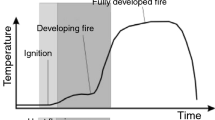Abstract
While thermogravimetric analysis can reveal the reaction mechanisms that occur during combustions, it cannot be used to study reactions involving large fuel loads. A large capacity thermobalance reactor is thus required to reveal thermal events that can have a substantial effect on reaction rates. The study presented in this article highlights the value of using macro-thermogravimetry to study the combustion of large loads of polyethylene, a representative thermoplastic polymer. A coupled analysis of mass loss and the corresponding heat flows reveals three distinct combustion regimes, which differ by the shape and position of the flame, which either remains above or, transiently or continuously, wraps around the load. In the first case, radiation from the flame only affects the upper surface of the load and has little effect on the combustion rate. In the second case, the integrated effect of this radiation on part of the outer surface of the crucible substantially accelerates the process, which eventually slows as the flame relocates above the charge. The third regime occurs for large loads, when the filling factor of the reactor is high. The radiation affects the entire external surface of the load, leading to very high combustion rates until the polymer is completely consumed. Simulations of the combustion process support the conclusions derived from experimental data. These results should prove valuable for the development of robust and effective techniques to destroy dangerous organic materials.















Similar content being viewed by others
References
Akubo K, Nahil MA, Williams PT. Aromatic fuel oils produced from the pyrolysis-catalysis of polyethylene plastic with metal-impregnated zeolite catalysts. J En Inst. 2019;92–1:195–202.
Ng SH, Seoud H, Stanjciulescu M, Sugimoto Y. Conversion of polyethylene to transportation fuels through pyrolysis and catalytic cracking. Energy Fuels. 1995;9:735–42.
Almustapha MN, Andresen JM (2011) Catalytic conversion of high density polyethylene (HDPE) polymer as a means of recovering valuable energy content from plastic wastes. In: International conference on petroleum and sustainable development IPCBEE 26 (2011) IACSIT Press, Singapore.
Lee KH (2012) Pyrolysis of waste polystyrene and high-density polyethylene, material recycling–trends and perspectives. 2012, InTech.
Motawie M, Hanafi SA, Elmelawy MS, Ahmed SM, Mansour NA, Darwish MSA, Abulyazied DE. Wax co-cracking synergism of high density polyethylene to alternative fuels. Egypt J Petrol. 2015;24:353–61.
Khedri S, Elyasi S. Kinetic analysis for thermal cracking of HDPE: a new isoconversional approach. Polym Degrad Stabil. 2016;129:306–18.
Gonzalez H, Caro S, Toledo M, Olguin H. Syngas production from polyethylene and biogas in porous media combustion. Int J Hydrogen Energy. 2018;43–9:4294–304.
Piao M, Chu S, Zheng M, Xu X. Characterization of the combustion products of the polyethylene. Chemosphere. 1999;39:1497–512.
Font R, Aracil I, Fullana A, Conesa JA. Semivolatile and volatile compounds in combustion of polyethylene. Chemosphere. 2004;57:615–27.
Long S, Cao F, Wang S, Sun L, Pang J, Sun Y. Combustion characteristics of polyethylene and coal powder at high temperature. J Iron Steel Res Int. 2008;15:6–9.
Ali Nour M, Elgazery M. Combustion behavior of Polyethylene/modified montmorillonite clay nanocomposites prepared by ultrasonication. Polimery. 2010;55:452–6.
Peterson JD, Vyazovkin S, Wight CA. Kinetics of the thermal and thermo-oxidative degradation of polystyrene, polyethylene and poly(propylene). Macromol Chem Phys. 2001;202:775–84.
Balme Q, Lemont F, Rousset F, Sedan J, Charvin P, Bondroit J, Marias F. Design, calibration and testing of a new macro-thermogravimetric analyzer. J Thermal Anal Calorim. 2018;132:1439–47.
Stoliarov SI, Walter RN. Determination of the heats of gasification of polymers using differential scanning calorimetry. Polym Degrad Stabil. 2008;93:422–7.
Stuetz DE, Diedwardo AH, Zitomer F, Barnes BP. Polymer combustion. J Pol Sci Pol Chem Ed. 1975;13:585–621.
Sudheer S, Prabhu SV. Measurement of flame emissivity of hydrocarbon pool fires. Fire Technol. 2012;48:183–217.
Pastor E, Rigueiro A, Zarate L, Gimenez A, Arnaldos J, Planas E (2002) Experimental methodology for characterizing flame emissivity of small scale forest fires using infrared thermography techniques. In: IV International conference on forest fire research 2002 wildland fire safety summit (pp. 1–11).
Lallemant N, Sayret A, Weber R. Evaluation of emissivity correlation for H2O–CO2–N2/air mixtures and coupling with solution methods of the radiative transfer equation. Prog Energy Combust Sci. 1996;22:543–74.
Jiang FH. Prediction of Flame Radiation and Temperature in Polymer Combustion. Fire Saf. Sci. 1995;2:298–307.
Bard S, Pagni PJ. Spatial variation of soot volume fractions in pool fire diffusion flames. Fire Saf Sci. 1986;1:361–9.
Kim NI, Lee UD, Shin HD. Extinction of a premixed flame by a large variation in axial velocity. Combust Flame. 2004;136:467–80.
Author information
Authors and Affiliations
Corresponding author
Additional information
Publisher's Note
Springer Nature remains neutral with regard to jurisdictional claims in published maps and institutional affiliations.
Rights and permissions
About this article
Cite this article
Lemont, F., Balme, Q., Bondroit, J. et al. Different combustion modes and flame shapes in massive loads of polyethylene revealed by macro-thermogravimetry. J Therm Anal Calorim 143, 3047–3055 (2021). https://doi.org/10.1007/s10973-020-09868-5
Received:
Accepted:
Published:
Issue Date:
DOI: https://doi.org/10.1007/s10973-020-09868-5




